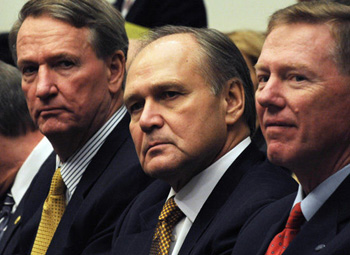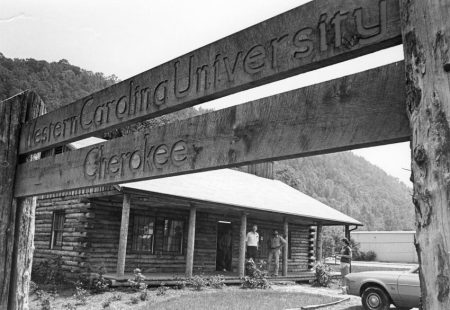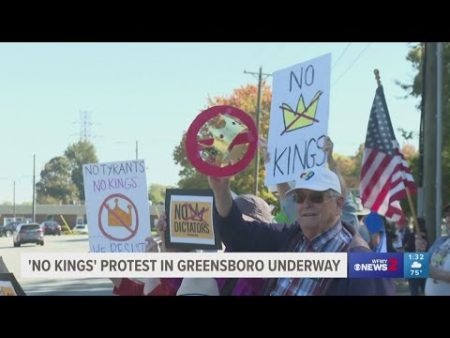Auto Bailout Gives Lawmakers Chance For Real Change
 |
| All three CEOs – Rick Wagoner of GM, Alan Mulally of Ford, and Robert Nardelli of Chrysler. Mulally’s corporate jet is a perk included for both him and his wife as part of his employment contract along with a $28 million salary last year. Mulally’s family lives in Seattle, not Detroit. The company jet takes him there and back on weekends. |
After voting against the wishes of the American people to give wealthy bankers an $800 billion “no-strings-attached” payout for faulty business practices, Congress was forced again to consider another major bailout, this time to the failing automobile industry.
By Stack Kenny
Following testimony by auto executives who attempted to delay the demise of their companies through pleas for $34 billion of taxpayer money, lawmakers seemed poised to commit $15 billion for an immediate interim fix of the problem. Democrats had wanted the money to come from the $800 billion given to Wall Street, but the White House assured Congress the president would veto any such attempt.
The money instead will come from an inexplicably unused $25 billion fund held by Congress to modernize auto plants and promote more efficient vehicles. The $15 billion loan is meant to float Ford, Chrysler, and General Motors until March, when a new president and Congress will have to deal with the devastating results of economic policies initiated by the Bush, Clinton, and Reagan Administrations.
For now, the fate of the Big Three automakers and the millions of
workers associated with the industry is on hold, with no new surprises
expected until after the holiday season. With labor statistics
revealing over a half million American jobs lost in November alone,
Congress at least knows the country cannot afford to add several
million new names to this list, especially at Christmas.
A Conflicted Public
Polls show Americans are somewhat divided in their opinions
of the auto bailout. Most people are justifiably angry at the greed and
arrogance of corporate executives who flew to the Congressional
hearings in personal jets, without a business plan, still ensconced in
a gas-guzzling mentality, and lagging well behind foreign competitors
in their production of affordable low-emission/high-gas-mileage
vehicles.
But despite the disdain for auto executives, Americans also
realize the dire implications that allowing these companies to fail
would bring to blue collar factory workers, auto parts dealers, car
mechanics, and show room dealers, and the additional negative effect
this would have on an already staggering U.S. economy. They are
increasingly skeptical of a national government that seems ready to
support backroom speculative business practices while allowing the
working population to suffer through the recession these businesses
created.
While automakers and some politicians attempt to blame the
workers for the problems in Detroit, Americans still do not want to see
more executives bailed out for their mistakes. What will happen to the
millions of people employed in the industry remains to be seen.
A Short History of the Auto Industry Collapse
The century-old relationship between the oil and auto
industries revolves around one simple tenet: the development and
subsequent maintenance of the oil-powered internal combustion engine.
Despite being the greatest technological and influential
breakthrough of the 19th and 20th centuries, the massive use of this
combustion technology over the last 60 years has proved to be the
greatest source of pollution, health risk, and inherent danger our
planet has ever witnessed. Scientists have unanimously agreed that if
we do not stop burning fossil fuels at this enhanced rate, our world as
we know it will be in danger of perishing.
Still, there are such gigantic profits to be made by combining
fossil fuel and combustion engines that many captains of industry and
finance seem willing to take the risk into the unforeseen future. Along
with the military-industrial complex, and the massive energy companies
that extract natural resources from around the globe, auto executives
running the Big Three for the last half-century are responsible for
this uncertain planetary predicament.
The problems these car companies face reflect the continuing
relationship with oil companies, resulting in a refusal to produce
newer emerging products from clean, non-combustion-powered technology.
Over the years, auto companies, with the help of government
officials, have a history of subverting these non-polluting
technologies. As early as 1947, General Motors consorted with Standard
Oil, Firestone Tire, and California politicians to buy the electric
trolley system of Los Angeles for pennies on the dollar. Soon after,
the non-polluting trolley system was dismantled and individual cars
replaced the public transportation system. Los Angeles is now the most
polluted city in America.
Fifty years later, in 1996, after California passed a
zero-emissions mandate, auto companies were forced to design a
non-combustion-powered vehicle. Young, enthusiastic designers at GM
came up with the EV 1, an electric car that eventually drove 300 miles
on a single charge. Both Ford and Chrysler also came up with
non-polluting electric cars.
These vehicles were offered to the public through a lease-only system,
apparently to measure public demand. Many famous Americans, such as Tom
Hanks and Mel Gibson, signed on, and soon the companies could not meet
the demand. But the car companies showed no interest in promoting
electric cars and behind the scenes continued to fight the California
mandate for emission control standards.
In 2000, with oil company money behind them, they aligned with
the Bush Administration and eventually overturned the emission control
mandate. The EV 1 leases were recalled soon after, and by 2006 the last
of these electric cars were crushed and shredded at a GM facility in
Mesa, Arizona. At the same time, the patent for the long distance
battery, built by renewable resource inventor Stanford Ovshinsky, was
sold to oil giant Conoco Phillips. General Motors then committed itself
to push through on its latest project: the Hummer.
Now, as auto executives promise Congress to put more money into
research and development of clean cars, they forget to mention the
technology already exists.
The Future is Up For Grabs
What will Barack Obama and the next Congress do when they
have to address this problem after the inauguration? As America sinks
deeper into an unclear picture of recession/depression, it seems
unlikely that business as usual will pull Detroit automakers out from
their imminent death sentence. The market for big expensive trucks,
SUVs and Hummers is over.
Banks no longer give loans on these overprized gas guzzlers
anyway. The best new technology GM can offer at this time is the
unaffordable $45,000 hybrid, the Volt. Yet Congress is forced to bail
out another set of shortsighted, quick-fix CEOs who, as industry critic
Ralph Nader recently asserted, “Want to lead us backwards into the
future.”
Nader, along with writer/filmmaker Michael Moore, agrees with
discussions now surfacing through American thought that the auto
industry meltdown provides lawmakers the perfect opportunity to lead
the country in a sorely needed positive direction. Right now is the
time to begin transferring the country from a combustion-powered
economy into a green economy by taking over the antiquated auto
industry, converting its massive industrial technical infrastructure
away from combustion and into existing renewable energy technologies.
Factories and jobs that once made gas-guzzling, polluting
machines could easily be refitted to make solar panels, electric cars
and buses, light rail, subways, and alternative fuel-powered cars and
machines. The benefits to the environment, health, and the general
welfare of the population are obvious. As Michael Moore wrote, “This
proposal will save our industrial infrastructure and millions of jobs.
More importantly, it will create millions more. It literally could pull
us out of this recession.”
Will Congress and newly elected U.S. President Barack Obama have
the vision and courage to look into the future and make some immediate
decisions for the working people of the United States? Or will they
continue, dragging their feet into the 21st century.
For now, real decisions have been postponed until January. But the problems in Detroit will still be brewing.







